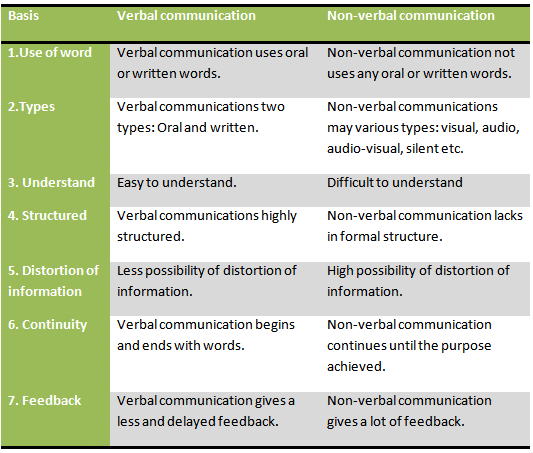Differences between verbal and non-verbal communication: Verbal communication is the expression or exchanged of information or messages through written or oral words.
On the other hand, non-verbal communication is the expression or exchanged of information or messages through without using any spoken or written word. The important differences between verbal and non-verbal communication are as follows:

Medias or ways or methods or kinds of non-verbal communication: Non-verbal communication is the expression or exchanged of information or messages through without using any spoken or written word. Several symbols can be used in non-verbal communication. We will discuss here only the following types of communication that occur without words.
A. Body language: Some parts of our body can express many indications without any sound. Message can be transmitted with the help of our body movements which is called body language. Body language is a form of non-verbal communication, which consists of posture, gestures, facial expressions, eye movements etc.
Facial expression: A facial expression is one or more motions or positions of the muscles in the skin of face. These movements convey the emotional state of the individual to observers. Facial expressions for happiness, sadness, anger and fear are similar throughout the world. Proverb says, “Face is the index of mind.”Example: By waving our hands we express ‘good-bye’; by shaking our head from side to side we express “we do not know”.
Gestures: Gestures refers to visible bodily actions communicate particular messages which include movement of the hands, face, eyes, head or other parts of the body. Common gestures include waving, pointing, and using fingers to indicate numeric amounts. Culture-specific gestures that can be used as replacement for words, such as the hand wave used in western cultures for “hello” and “goodbye”.
Posture: Posture indicates the position in which we hold the body when standing or sitting. It can help to communicate non-verbally. Consider the following actions and note cultural differences:- Bowing not done criticized or affected in US; shows rank in Japan.
- Slouching rude in most Northern European areas.
- Hands in pocket-disrespectful in Turkey.
- Sitting with legs crossed-offensive in Ghana, Turkey.
- Showing soles of feet-offensive in Thailand, Saudi Arabia.
Eye Gaze or Eye contact: Eye contact indicates looking, staring and blinking etc. which is important in nonverbal behaviors. Looking at another person can indicate a range of emotions, including hostility, attention, interest and attraction, defines power and status and has a central role in managing impressions of others.
Appearance and dress: External appearances also play a vital role to communicate others. Our clothes an dresses provide a good visual signal to our interest, age, personality, taste and sex. Our choice of color, clothing, hairstyles and other factors affecting appearance are also considered a means of nonverbal can evoke different moods. Consider differing cultural standards on what is attractive in dress and on what constitutes modesty. For example, seeing the dress of army officers, we can easily determine the job status.
Touch: Touch is culturally determined. But each culture has clear concept of what parts of the body one may not touch. Basic message of touch is to affect or control-protect, support and disapprove (i.e. hug, kiss, hit, kick)
- USA-Handshake is common (even for strangers), hugs and kisses for those of opposite gender or of family (usually) on an increasingly more intimate basis.
- Islamic and Hindu- Typically don’t touch with the left hand. Left hand is for toilet functions.
- Islamic cultures generally don’t approve of any touching to opposite genders (even handshakes). But consider such touching (including hand holding, hugs) between same sexes to be appropriate.
7. Silence: Silence is another form of non-verbal communication which expresses the positive or negative meanings of particular messages. In a classroom, silence indicates that students are listening carefully and attentively.
B. Space or proximity: People often refer to their need for “personal space”, which are also important types of nonverbal communication. The physical distance between you and others signals your level of intimacy and comfort. If someone you don’t know stand too close or touches too often, you will probably begin to feel uncomfortable.
C. Time: Another type of non-verbal communication involves time. Thant is how we give meaning to time communicates to other. For example, begin late in work everybody a worker can be considered as a man of carelessness but if a manager does it; we say it is a symbol of power. We know, time can play a vital role to reduce tension, conflict among groups. It is said that- “Kill the time to delay the justice”.
D. Paralinguistic (Tone and volume of voice): Paralinguistic refers to vocal communication that is separate from actual language. Paralanguage also include such vocal characteristics as rate (speed of speaking), pitch (highness of lowness of tone), inflection, volume (loudness) and quality (pleasing or unpleasant sound).
- Vocal characterizers (laugh, cry, yell, moan, whine, belch and yawn). These send different message in different cultures (Japan- giggling indicates embarrassment; India- belch indicates satisfaction)
- Vocal qualifiers (volume, pitch, rhythm, tempo and tone). Loudness indicates strength in Arabic cultures and softness indicates weakness; indicates confidence and authority to the Germans; indicates impoliteness to the Thai; indicates loss of control to the Japanese. (Generally, one learns not to “shout” in Asia for nearly any reason). Gender based as well women tend to speak higher and more softly than men.
- Vocal segregates (UN-huh, shh, uh, ooh, mmmh, hummm, eh mah, lah). Segretates indicate formality, acceptance, assent, uncertainty.
E. Visual communication: When communication takes place by means of any visual aid, it is known as visual communication. Such as facial expression, gesture, eye contact, signals, map, chart, poster, slide, sign etc. for example, to indicate ‘danger’, we use red sign, to indicate ‘no smoking’, we use an image showing a lighted cigarette with across mark on it etc.
Kinds of Non-Verbal Communication
No comments:
Post a Comment